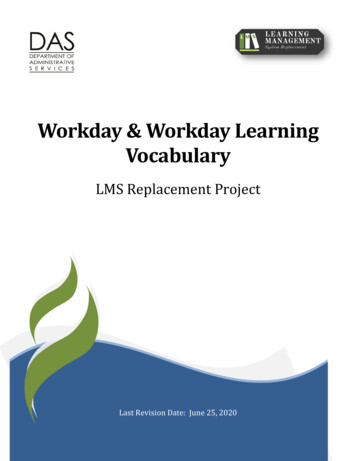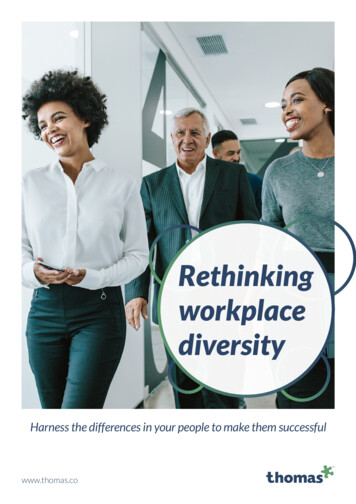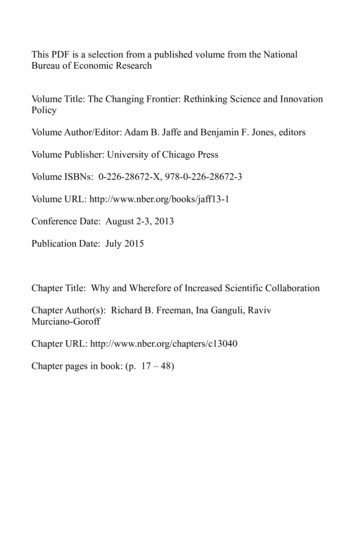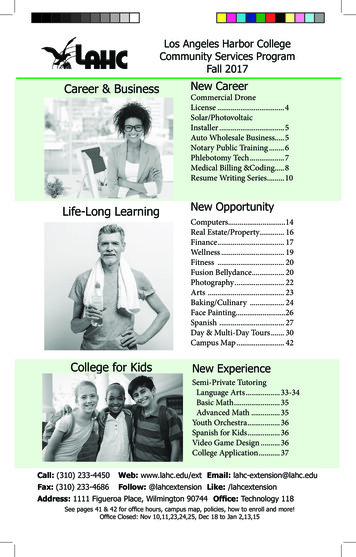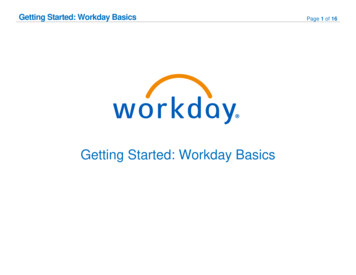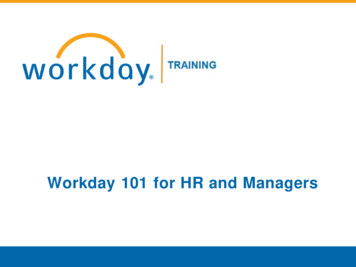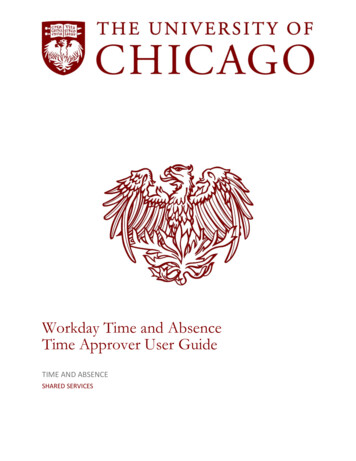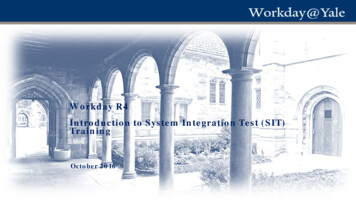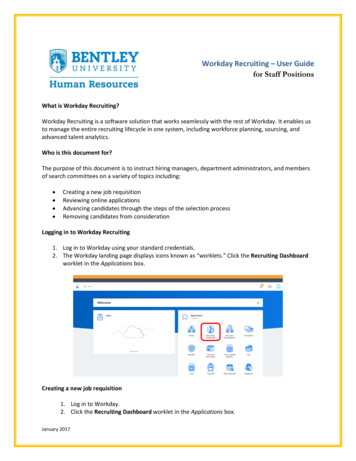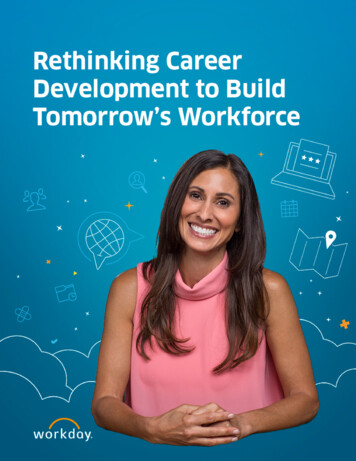
Transcription
Rethinking CareerDevelopment to Build Tomorrow’s WorkforceOver the past few hundred years, our world has experienced three different industrialrevolutions—the first driven by the use of steam, followed by electricity, and theninformation technology. Now there’s another revolution upon us, and its most markedcharacteristic is the dizzying speed of innovation.This “fourth industrial revolution,” as it’s been called, affects industries and marketsaround the world. It also affects the nature of how we work. Unprecedented accessto knowledge, more processing power, and the rise of new types of technology likeartificial intelligence and quantum computing will fundamentally change productivityand efficiency for the next generation of workers.While it may be too soon to know exactly how these technologies will change day-today work, we do know that it’s going to change the nature of work, and the look andfeel of our careers. We are already beginning to see a departure from the traditional,linear career path. Job satisfaction is taking on new meaning for those entering theworkforce as well as for those who have been in it for decades. Today’s workers arepassionate about cross-team collaboration, and are eager to quickly take on newresponsibilities and develop new skill sets. They don’t want to spend years grindingaway in a role to earn those opportunities, and want more career mobility. A recentstudy shows that today, the average worker only spends 4.4 years in a specific job,and millennials only half that.1
This shift in the workforce will impact each part of the employee lifecycle, fromrecruitment and talent retention to employee engagement and performanceenablement. With so many more opportunities, employment becomes a two-way streetthat will require increased personalization to keep employees motivated. This is notjust an HR issue. Declining employee engagement also leads to a decline in overallrevenue growth.If we don’t keep up with this rapidly changing workforce, we’ll find ourselves withoutthe talent, skills, organizational agility, and ability to innovate that the best leadersseek. To build a workforce that can withstand these changes and thrive during thenext revolution, we must rethink our approach to career development and refocus ourefforts to build the leadership of tomorrow.This will require us to invest in foundational leadership development at every level inthe organization: from the green graduates fresh out of college to the experienced andtenured senior managers. We must also make an effort to foster meaningful employeeconnections and mentorship relationships to inspire, motivate, and create better careerpaths. Finally, we must provide ample opportunities for learning regardless of therole: the more skills we offer, the greater value we provide to the individual and thecompany as a whole.IF WE DON’T KEEP UP WITH THIS RAPIDLYCHANGING WORKFORCE, WE’LL FIND OURSELVES WITHOUT THE TALENT, SKILLS, ORGANIZATIONAL AGILITY, AND ABILITY TO INNOVATETHAT THE BEST LEADERS SEEK.Nurture Future LeadersWe should ensure that leadership skills are taught regardless of whether an employeeis a direct people manager or not. For those that do manage people, developing theright skills is critical. Bad management is one of the top contributors to low employee2
engagement, and ultimately, poor retention. As has been said, people join companies,but they leave managers. The reality is that many successful employees will becomepeople managers at some point during their careers, despite the fact that they don’thave the right experience or skills when they step into the role. In fact, a recentGallup survey suggests that only 1 in 10 employees have what it takes to be a goodpeople manager.What’s more, employees will likely imitate, for better or worse, the management stylethey’ve seen firsthand. Without the opportunity to learn best practices in managementor general leadership skills, companies are perpetuating a vicious cycle of bad leadersthat can ultimately create bigger problems across the company.What more can organizations do to help employees develop the critical skills neededto lead? One idea is to weave training and career development opportunities intothe fabric of your company culture. We’ll come back to this later, but by providing astructured program early in their careers, you ensure that employees get a head starton developing their leadership skills. Rotational programs, for example, give employeesthe opportunity to experience different roles within the company and get a betterunderstanding of what a career in that area would require.More established leadership tracks, such as 3M’s four-level experiential developmentprogram, target employees at different levels in their careers, providing experiencesthat speak to their skill level and future potential. 3M’s programs range in length from3 to 12 months and include a discovery process for the leaders, spot coaching, 360feedback, and a capstone project to be completed at the end to show learning impactand how employees can apply the skills in their day-to-day jobs.With technology and HR systems innovating at a galloping pace, we are also gainingmore insight into individual performance. By harnessing employee data, we canidentify top performers early on, understand what makes them successful, anduse that knowledge to improve everything from personalized career paths torecruiting practices.3
BY HARNESSING EMPLOYEE DATA, WE CANIDENTIFY TOP PERFORMERS EARLY ON,UNDERSTAND WHAT MAKES THEM SUCCESSFUL,AND USE THAT KNOWLEDGE TO IMPROVEEVERYTHING FROM PERSONALIZED CAREERPATHS TO RECRUITING PRACTICES.The smarter our systems become, the more time managers will have to focus onemployee development. According to a recent survey, managers at all levels spendmore than half their time on administrative coordination and control tasks. Asdevelopments in artificial intelligence begin to automate many of these tasks, managerswill have more bandwidth to spend on employee development.Some companies are investing in one-on-one training programs to help employeesdevelop “soft skills” such as peer-to-peer communication, public speaking, negotiation,and expectation-setting. Aaron Feinberg, an executive coach and leadership trainer,works with companies of varying sizes and industries to help their employees developgreater emotional intelligence—skills he believes are the backbone of a great leader.“As a manager and a leader, one of your most important responsibilities is to motivateyour employees. You can’t do that if you haven’t built trust and rapport with them usingyour emotional intelligence skills—getting outside of yourself and thinking about them,”says Feinberg. “Through active listening, open questions, and encouragingself-awareness, you can find out their internal motivations, and help them live their values.”Identifying personal leadership style and individual strengths will help employeesbecome better leaders and assist those they work with or manage in becoming betterleaders themselves. Through focused training programs, whether in a group orone-on-one setting, and better insights with the help of technology, we can help allmanagers and employees reach their full potential.4
As a manager and a leader, one ofyour most important responsibilitiesis to motivate your employees.Encourage MentorshipThe New York Times best-selling author and “mentor-capitalist” Anthony Tjan foundthat among the 100 or so leaders from various industries he researched for his recentbook, there’s one characteristic they all have in common: they do everything theycan to imprint their “goodness” onto others in ways that make people feel like fullerversions of themselves. By this logic, we should be facilitating knowledge transfers asmuch as we can to increase the prevalence of good leaders.Mentoring uses the resources your company already has to improve employeesatisfaction, develop leadership, and create lasting relationships with peers. Bothparties involved in a mentoring program gain the opportunity to recognize theirabilities and limitations, highlighting areas for future development. Most importantly,mentoring serves as an opportunity outside of regular work interactions in which onecan discuss career opportunities, the optimal paths to growth, and how to get therewith leadership support.Breaking it down further, for the mentee, it’s an advantage to have someone in asenior role outside of your management chain that can provide unbiased guidance onareas you are unfamiliar with, and serve as an ally when opportunities or promotionscome up.5
For the mentor, discussing issues with a mentee can help develop and renewcommunication skills. In many cases, this relationship can act as a link betweengenerations, bridging the gap between work styles to help company leadership betterunderstand younger workers and what they can expect from the future workforce.Building these essential connections also helps company leadership identify futureleaders and put them on the track to success. Technology and more advancedperformance enablement practices can help us build stronger connections with peers andidentify potential career paths. By looking for similar contributions and career goals, wecan connect employees with mentors who are able to offer more meaningful feedback.Companies have also leveraged mentorship programs to target groups of employeesthat need extra career support. According to Pew Research, 39 percent of womenare likely to take a significant amount of time off due to family-related events. Intuitrecognized the difficulty women have in returning to their careers after leaving theworkforce, so they started Intuit Again, a mentorship program in India that helpswomen who have taken a break reenter the workforce and sharpen their professionalskills through a six-month internship. In the program’s first year, 50 percent ofparticipants were hired into full-time positions upon completion of their internships.Before you establish a mentorship program at your own company, consider what therequirements are for a meaningful relationship to work. There are two important thingsto remember:1) Establish goals from the outset.Outline what you would each like to get out of the relationship before you develop a regularcadence of meetings, then refer back to those goals at points throughout your relationship.2) Make the relationship a priority.It’s not hard to fall into the bad habit of taking a “check the box” approach tomentorship instead of building something authentic and mutual. For the relationship towork, both parties need to be motivated and engaged, working toward a common goal.6
In the end, mentorship is about people helping other people reach their highestpotential. By utilizing the tools and practices at your disposal, you can improve overallemployee satisfaction and retention, enrich careers, and ultimately help your companybuild stronger leadership.TECHNOLOGY AND MORE ADVANCEDPERFORMANCE ENABLEMENT PRACTICES CANHELP US BUILD STRONGER CONNECTIONSWITH PEERS AND IDENTIFY POTENTIALCAREER PATHS.Create a Culture of LearningWe’ve covered how to develop better people managers, but leadership, emotionalintelligence, and other skills are important for all employees. To that end, establishing aculture of learning is vital to ensuring everyone at your company, people managers andindividual contributors alike, are effectively developing new skills and finding value intheir careers.It’s clear that organizations are starting to connect the need for better learningopportunities with business success. This year, improving employee careers andtransforming corporate learning emerged as the second most important trend inDeloitte’s 2017 Global Human Capital Trends survey, up from fifth last year.This urgency is compounded by the fact that 42 percent of millennials say they arelikely to leave their company because they are not learning fast enough.While there have been significant developments in learning technology over thelast few years, adopting a traditional learning model isn’t the only way to encourageindividual development. Simply increasing the frequency of new experiences in acurrent role will have a strong impact on an employee’s career.What this looks like in practice will be different for everyone, but it can start with aconversation, whether it’s a one-on-one between manager and employee, or a more7
structured company-wide initiative led by the CEO. Encourage employees to do anhonest assessment of their work, the responsibilities outlined in their jobs, and theskills required to get where they want to go next.42 PERCENT OF MILLENNIALS SAY THEYARE LIKELY TO LEAVE THEIR COMPANYBECAUSE THEY ARE NOT LEARNINGFAST ENOUGH.Company leadership plays a major role in the success of a learning environment.Leaders must support employees’ attendance at classes, activities, and online programsthat support the objectives they have laid out. Companies should look to leverageonline learning, including setting up an internal learning environment to share companybest practices and user-generated content, as well as looking to external providers suchas Coursera and Udacity to offer more wide-ranging material.Workday Chief People Officer Ashley Goldsmith suggests companies make onlinelearning opportunities as personalized as possible to see the best results.“Take a page from Netflix, and make proactive recommendations on content that canposition employees for growth in a new area,” says Goldsmith. “Bring it to the nextlevel by giving your employees the opportunity to create learning content in their areasof expertise, similar to producing their own YouTube tutorials. By providing employeeswith the opportunity to learn and teach on their own, you empower them to becomebetter at their current role and beyond.”There is a plethora of learning opportunities outside of digital classes as well.On-the-job training such as stretch assignme
Through focused training programs, whether in a group or one-on-one setting, and better insights with the help of technology, we can help all managers and employees reach their full potential. BY HARNESSING EMPLOYEE DATA, WE CAN IDENTIFY TOP PERFORMERS EARLY ON, UNDERSTAND WHAT MAKES THEM SUCCESSFUL, AND USE THAT KNOWLEDGE TO
